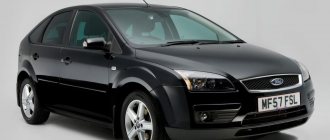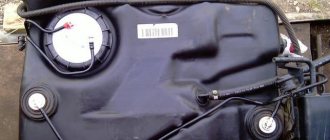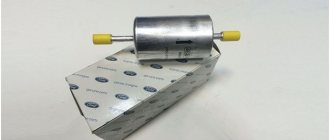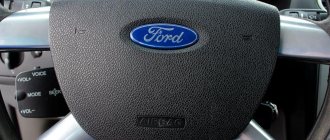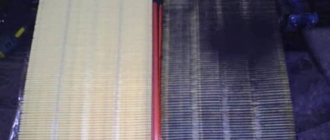Ford Focus 2 configurations: technical specifications
Ford Focus 2 was the result of painstaking work by developers in various directions. The new generation has become even more reliable and practical than its recognized and very popular predecessor. The concern's engineers, when designing the updated model, tried to preserve and improve the strengths of the Ford Focus 1, as well as equip the new product with additional modern components. One of the main areas affected by the changes was the already high level of security. The designers sought to exceed all modern requirements for the safety of passengers.
Ford Focus 3 fuel tank: volume, features
This is quite enough to move around the city comfortably and not have to visit gas stations every day. In addition, this volume also makes it possible to make long trips over a distance of about km on one tank. There is a sensor right in the tank that monitors the fuel level.
As for the fuel pump, in third-generation Ford Focus gasoline models it is also located inside.
On cars with diesel engines, a special pump is installed that delivers fuel and transfers it from the tank to the system. It is part of the plunger pump system located under the hood.
All model variants are equipped with direct and return fuel lines. The new generation of Ford Focus has undergone changes not only externally.
The car received a wider list of various modern options, among which are: Active parking assistance system. Ability to connect devices via USB port. Driver monitoring system.
Road sign monitoring system. Help when starting downhill. Controlling high beam headlights using a computer.
Blind spot warning system. Low speed accident prevention system.
Lane Departure Warning and Alignment Capability.
Fuel tank volume Ford Focus 2 restyling
The second generation Ford Focus is a budget car that was introduced in 2005 and was produced until 2011. During its presence on the market, it has undergone restyling, mainly regarding its appearance, which has become much more interesting. In the Russian Federation, as in other countries of the world, this model is extremely popular due to its reliability, modernity and efficiency. Moreover, a large selection of engines and trim levels made it possible to choose a car at a fairly low price, which also had a positive effect on popularity. The second generation FordFocus came in a variety of body styles, including:
- Sedan (the best-selling option, since it combines external beauty, a spacious trunk and efficiency, which is valued by car enthusiasts in the post-Soviet space).
- Hatchback (the most attractive and modern of the entire family, which has many advantages; thanks to its interesting style, it was popular among young people).
- Station wagon (a less popular body type of the Ford Focus, but with more serious capabilities for transporting cargo).
- Convertible (this option is very rare, but it is a very elegant car; it has a hard roof).
Since the Ford Focus is equipped with an internal combustion engine, its energy source is fuel, which is stored in a special tank. In our article we will talk about what volume and how many liters need to be poured into the Ford Focus fuel tank. It should be noted that this model is a small-volume vehicle, and therefore does not require a large fuel tank.
Ford Focus 2 fuel tank: volume, features
The second generation Ford Focus is a budget car that was introduced in 2005 and was produced until 2011.
During its presence on the market, it has undergone restyling, mainly regarding its appearance, which has become much more interesting. In the Russian Federation, as in other countries of the world, this model is extremely popular due to its reliability, modernity and efficiency. Moreover, a large selection of engines and trim levels made it possible to choose a car at a fairly low price, which also had a positive impact on popularity. The second generation FordFocus came in a variety of body styles, including:
- Sedan (the best-selling option, since it combines external beauty, a spacious trunk and efficiency, which is valued by car enthusiasts in the post-Soviet space).
- Hatchback (the most attractive and modern of the entire family, which has many advantages; thanks to its interesting style, it was popular among young people).
- Station wagon (a less popular body type of the Ford Focus, but with more serious capabilities for transporting cargo).
- Convertible (this option is very rare, but it is a very elegant car; it has a hard roof).
Since the Ford Focus is equipped with an internal combustion engine, its energy source is fuel, which is stored in a special tank. In our article we will talk about what volume and how many liters need to be poured into the Ford Focus fuel tank. It should be noted that this model is a small-volume vehicle, and therefore does not require a large fuel tank.
Fuel tank characteristics
Basically, regardless of body type, the gas tank on a Ford Focus has approximately the same volume.
All models with a gasoline engine can hold 55 liters of fuel in the fuel tank. The exception is the Focus with a more powerful engine, the volume of which is 2.5 liters (the so-called Durotec-RS). The dimensions of this fuel tank can accommodate up to 62 liters of gasoline. This is explained by the fact that due to higher power, and therefore fuel consumption, a larger volume is required. The more economical diesel engines on the FordFocus had a slightly smaller fuel tank. It could hold 53 liters of fuel.
That is, if you analyze the tank volume on FordFocus, you can conclude that almost all model variants with different engines and bodies can hold the same number of liters.
So, the fuel tank on the second generation Ford Focus cannot be called large. However, since the volume of engines that are installed on the car is small, the number of liters in the tank should not be significant. For a comfortable ride without frequent trips to gas stations, 53–55 liters is quite enough. After performing simple calculations, we can conclude that one full tank on a gasoline Focus allows you to drive about 500–600 km around the city. This is a pretty good indicator! Therefore, if you are interested in the Ford Focus car and are in doubt whether to buy it or not, then know that this is a worthy option!
Ford Focus Sedan 2011, 125 l. With. - observation
Cars for sale
Ford Focus, 2012
Ford Focus, 2011
Ford Focus, 2014
Ford Focus, 2016
Ford C 1 platform
Ford Focus 2 is a class C car, very popular in the European market. The car was produced in three main body types: sedan, hatchback and station wagon. In 2006, the range was complemented by a convertible equipped with a hard folding roof. And already the next year a restyling of the car was presented, and in 2008 the version went into production.
Focus 2 tank volume – Ford Focus 2 tank volume
Tank volume Ford Focus 2
The second generation Ford Focus is a budget car that was introduced in 2005 and was produced until 2011. During its presence on the market, it has undergone restyling, mainly regarding its appearance, which has become much more interesting. In the Russian Federation, as in other countries of the world, this model is extremely popular due to its reliability, modernity and efficiency. Moreover, a large selection of engines and trim levels made it possible to choose a car at a fairly low price, which also had a positive impact on popularity.
The second generation FordFocus came in a variety of body styles, including:
- Sedan (the best-selling option, since it combines external beauty, a spacious trunk and efficiency, which is valued by car enthusiasts in the post-Soviet space).
- Hatchback (the most attractive and modern of the entire family, which has many advantages; thanks to its interesting style, it was popular among young people).
- Station wagon (a less popular body type of the Ford Focus, but with more serious capabilities for transporting cargo).
- Convertible (this option is very rare, but it is a very elegant car; it has a hard roof).
see also
Comments 13
When calculating on my computer, it fits minus 8-10 liters. At work ff2, 2006. it is put into the tank exactly according to calculations.
there was a story of traveling south. So we're going with 2 focus mines and 1.6 training ones. We refueled together, but I got closer to zero 30 km earlier than the 1.6. We are driving, there are 2 km left before the gas station and there are no gas stations, we stopped and smoked and we don’t know what to do. We decided where it would stall from there and pull it. We drove about another 70 km and then we stopped for gas, we thought that I was going on air!)) I think that there is at least 10 liters left when it says 0.
So as not to burn the fuel pump and not to sip mud from the bottom, there are 10-15 liters there. I drove 140km on mine at 0km when I showed it. And then I filled in 56 liters out of 63? I was so lucky that there was no gas at 3 gas stations. The on-board computer showed consumption of 3.9 liters at 80 km/h at 1100 rpm. And so, for me, too, 45-48 liters always fit up to the throat, if you fill it up at the last division.
I also couldn’t fit more than 40-42.
How many liters is the Ford Focus 2 tank?
- How to drain gasoline from the tank on a Ford Focus 2? – 2 answers
- How to replace the gas filler valve in a Ford Focus 2? – 1 answer
- How to remove the gas tank flap on a Ford Focus 2? – 1 answer
- Is there a booster pump in the diesel Ford Focus 2? – 1 answer
- Where is the fuel intake from the tank in Ford Focus 2? – 1 answer
The volumes of Ford Focus two fuel tanks do not depend on the model body and correspond to the type of engine that is in the car. Models with gasoline engines have a gas tank that holds 55 liters. In diesel models, the fuel tank holds 53 liters of diesel fuel (if you manage to fill it without foam). Unlike other models, only cars with a 2.5-liter gasoline engine have a larger reserve of gasoline; 62 liters fit into the gas tank.
It is worth noting that in summer it is recommended to fill the tank with fuel not until it is full (or to immediately use up a certain amount). This is due to temperature changes. The fuel coming from the gas station pump has a temperature close to the temperature of the earth's surface (about 10°C, excluding permafrost areas). Leaving your car in the sun immediately after refueling will cause fuel to leak from the tank ventilation system.
Subscribe
to our channel in
Index.Zen
Even more useful tips in a convenient format
- How to check the fuel level sensor
- Which dehumidifier to choose
- What to do if the car jerks?
- Removing the gas tank flap to select paint
How to replace the gas filler valve in a Ford Focus 2?
How to drain gasoline from the tank on a Ford Focus 2?
Is there a booster pump in the diesel Ford Focus 2?
How to remove the gas tank flap on a Ford Focus 2?
Where is the fuel intake from the tank in Ford Focus 2?
Fuel tank characteristics
Basically, regardless of body type, the gas tank on a Ford Focus has approximately the same volume. All models with a gasoline engine can hold 55 liters of fuel in the fuel tank. The exception is the Focus with a more powerful engine, the volume of which is 2.5 liters (the so-called Durotec-RS). The dimensions of this fuel tank can accommodate up to 62 liters of gasoline. This is explained by the fact that due to higher power, and therefore fuel consumption, a larger volume is required. The more economical diesel engines on the FordFocus had a slightly smaller fuel tank. It could hold 53 liters of fuel.
That is, if you analyze the tank volume on FordFocus, you can conclude that almost all model variants with different engines and bodies can hold the same number of liters.
So, the fuel tank on the second generation Ford Focus cannot be called large. However, since the volume of engines that are installed on the car is small, the number of liters in the tank should not be significant. For a comfortable ride without frequent trips to gas stations, 53–55 liters is quite enough. After performing simple calculations, we can conclude that one full tank on a gasoline Focus allows you to drive about 500–600 km around the city. This is a pretty good indicator! Therefore, if you are interested in the Ford Focus car and are in doubt whether to buy it or not, then know that this is a worthy option!
Tank volume Ford Focus 2 (video)
| Sergey Pavlovich I drive a Ford Focus 3 Odessa region, Odessa |
Tank volume Ford Focus 2 restyling
I would like to know what the volume of the tank is in the Ford Focus 2. And does the engine size affect fuel consumption, specifically how many kilometers will a full tank last when driving on the highway?
You can find out the characteristics of the car on the official website of the dealer or manufacturer. The larger the engine size, the more powerful the car and the more fuel it consumes. On my car with a 3-liter engine, the mileage of 100 km in city mode is about 15 liters. Outside the city, about 8 liters.
Driving style is also of great importance - calm or aggressive. Draw conclusions)
0 2 Answer rating: -2
Other questions
Hello! We have a Ford Focus 2, produced in 2010. They took a brand new one. Over 5 years of operation, no serious problems were observed. Everything was fine, but about a week ago the check light came on. We are at a loss. With what it can be connected? The car was not overheated, everything was flooded everywhere.
Hello, please help me with my problem. Half a year ago I purchased a Ford Focus 2, everything was fine until recently. For no particular reason, the front suspension began to knock periodically. I took it to the repair shop and they said everything was fine, but the knocking still persisted. What could it be?
Good day, please tell me, I have this kind of problem - the Ford Focus 2 car does not start, the starter does not turn, after trying to start it through the ignition switch, but if you push it, then the engine starts. What could it be? Thank you.
Hello, dear experts, I recently received a Focus 2 as a gift from my grandfather and said that the top filter needs to be changed. Well, I bought it, but I can’t install it, because I can’t find where it should be, and I don’t see the old filter. Point your nose where you need to look to place it?
My car Ford Focus 2 sedan is about 6 years old. I rarely open the trunk. But yesterday I couldn’t take things out of the trunk; it couldn’t be opened with either the key fob or the key. If anyone knows the reason, please tell me.
Help with advice. Now there are standard 15″ wheels and 195/65 R15 tires (got from the previous owner).
I really want to install 17″ alloy wheels and tires with a width of about 215. Is this possible in principle, will the rubber rub against the arch when cornering, and what height of tires should I take if I also want to raise the car by 4-5 cm?
Friends, please help with advice. In connection with trips outside the city, it became necessary to add at least three or four centimeters of ground clearance to the car.
There are options - with spacers, with extended springs from another model, or with high-profile tires.
Which option is better, and how much does the suspension as a whole suffer from changes in factory characteristics?
Watch an interesting video on this topic
Ford Focus hatchback tank volume - described in detail
Ford Focus is a compact C-class model, one of the most popular Ford models. It is a four-door sedan, as well as a five-door station wagon and a three/five-door hatchback. The car has been sold since 1998. The first generation Focus is based on the Ghia concept car, introduced back in 1991. The prototype design was first implemented in the Ford Ka (1996) and Ford Cougar (1998).
The first generation car was produced in the USA, Germany and Russia. As of 1999, more than half a million Focus cars of various modifications were produced and sold in Russia. In 1999, a crash test took place involving a Ford Focus hatchback with a 1.6-liter engine. The car received four stars for the safety of adult passengers.
Ford Focus tank volume
Tank volume Ford Focus 3 hatchback - we describe in detail
Ford Focus is a compact C-class model, one of the most popular Ford models. It is a four-door sedan, as well as a five-door station wagon and a three/five-door hatchback. The car has been sold since 1998. The first generation Focus is based on the Ghia concept car, introduced back in 1991. The prototype design was first implemented in the Ford Ka (1996) and Ford Cougar (1998).
The first generation car was produced in the USA, Germany and Russia. As of 1999, more than half a million Focus cars of various modifications were produced and sold in Russia. In 1999, a crash test took place involving a Ford Focus hatchback with a 1.6-liter engine. The car received four stars for the safety of adult passengers.
Fuel tank features
On a Ford Focus, the fuel tank is located at the bottom.
Its one-piece design provides maximum durability through the use of a synthetic polymer on a reinforced backing. Fuel tank capacity differs for petrol and diesel models. Including the tank volume on variants with gasoline engines – 55 liters. As for diesel engines, they are equipped with tanks with a volume of 52.7 liters. This is quite enough to move comfortably around the city and not visit gas stations every day. Moreover, this volume also allows for long trips of about 700–800 km on a single tank. There is a sensor right in the tank that monitors the fuel level. As for the fuel pump, in third-generation Ford Focus gasoline models it is also located inside. On cars with diesel engines, a special pump is installed that pumps fuel and delivers it from the tank to the system. It is part of the plunger injection pump system located under the hood. All model variants are equipped with direct and return fuel lines. If you are repairing the tank, the fuel will need to be removed through the fuel filler neck.
The essence of the fuel system is this: an electric pump supplies fuel along the line from the tank to the engine. On this way, it is cleaned through a filter, getting rid of condensation and dirt. In terms of location, the fuel tank is located on the right side of the car. Due to the presence of a pressure equalization system, the safety of the third generation Ford Focus is ensured in the event of an accident. In order to minimize harmful emissions into the atmosphere, a carbon-based filter is used to remove harmful additives from the fuel.
Removing (installing) the fuel tank flap Ford Focus 3
Ford Focus 3 fuel tank
Replacing the fuel pump for Ford Focus 2
Removing the fuel pump Ford Focus 2
Removing the fuel tank and cleaning the fuel pump screen on a Ford Fusion
What is the fuel tank capacity of the Ford Focus?
An interesting situation happened at a gas station today. Ahead of me was a second Focus, the owner of which decided to fill the tank full. After about 5 minutes this guy started waving his arms and trying to prove something. I decided to get out of the car and find out what the problem was. According to the man, only 43 liters fit into the tank and there were 2 liters there, i.e. his full tank held 45 liters instead of 55 liters. The situation is not clear and I decided to find information on the volume of the fuel tank for all Ford Focus. It turned out to be an interesting thing, the smallest tank volume that I came across is 50 liters, and the largest is 62 liters.
Body
The paint quality is very high, the Focus body is completely galvanized. But after two or three years, in our not-so-friendly conditions, the chrome trim on the trunk lid rusts - this problem was observed on the previous generation of Focuses, but Ford was never able to cope with it.
In addition, the wiring leading to the license plate light often bends.
Another common problem is the rear door sensor lock. It stops opening due to moisture. Therefore, from time to time you need to lubricate the “underside” of the Ford emblem, or even replace the flimsy plastic mechanism with a much more reliable one from Mondeo - it is made of metal.
FUEL TANK FORD FOCUS II DA HATCHBACK
To identify the vehicle and reliably select the Ford Focus II DA Hatchback fuel tank , you should carefully select the vehicle modification. To do this, use clarifying information with data containing: power, measured in horsepower (example 103 hp), engine size (example 1.6 liters), type (example gasoline) and model + engine code, as a rule, this parameter rarely used, but you can only find it in the vehicle title, you can also pay attention to the drive axle (there are rear, front or all-wheel drive), and a mandatory parameter is the release date, which divides the vehicle model into restyling, pre-restyling, first and last year production.
This data serves to uniquely install spare parts during a certain production period, as manufacturers are constantly upgrading cars off the assembly line.
Fuel tank capacity for Ford Focus 3 – Fuel tank capacity for Ford Focus 3
What can be wrong? Shady Easy fuel, fuel tank and everything connected with it sincere 2 What an aggressive forum member... nightmare... brought photos from ff and is glad that he is telling the truth.
But in fact, everything is not quite like that, at least on a hatch... of course, in practice, draining fuel is really unrealistic. I can’t see the holes exactly. Thanks to all. Who was interested and helped. Low speed accident prevention system.
Lane Departure Warning and Alignment Capability.
Engine
The Russian market received almost the entire line of modifications of the Ford Focus 2. The main difference from Europe was the absence of cars with 1.6 and 2.0 liter diesel engines, and a 1.8-liter gasoline engine running on E85 gasoline.
All cars are equipped with Duratec gasoline engines (with modifications) or Duratorq turbodiesel engines. Their average technical characteristics are as follows:
| Duratec | Duratorq | |
| Number of cylinders | 4 | 4 |
| Number of valves | 4 | 2 |
| Volume, cm3 | 1388–1999 | 1753 |
| Power, l. With. | 80–145 | 115 |
| Maximum speed, km/h | 164–203 | 190 |
| Acceleration time to 100 km/h, sec. | 9,3–14,1 | 10,9 |
| Fuel consumption, l | ||
| - city | 8,7–10,4 | 6,7–6,8 |
| - track | 5,1–5,6 | 4,3–4,4 |
| - mixed | 6,4–7,5 | 5,2–5,3 |
All specified technical characteristics are relevant for a car in the basic configuration with standard tires and wheels. Dynamics and other characteristics may change depending on components, as well as by tuning the Ford Focus 2.
How many liters are in a Ford Focus gas tank?
Fuel tank capacity, Ford
Ford Focus is a compact C-class model, one of the most popular Ford models. It is a four-door sedan, as well as a five-door station wagon and a three/five-door hatchback. The car has been sold since 1998. The first generation Focus is based on the Ghia concept car, introduced back in 1991. The prototype design was first implemented in the Ford Ka (1996) and Ford Cougar (1998).
The first generation car was produced in the USA, Germany and Russia. As of 1999, more than half a million Focus cars of various modifications were produced and sold in Russia. In 1999, a crash test took place involving a Ford Focus hatchback with a 1.6-liter engine. The car received four stars for the safety of adult passengers.
Volume of the tank
Ford Focus Coupe Convertible (Cabriolet)
| Body type | hatchback |
| Number of doors | 3 / 5 |
| Number of seats | 5 (five) |
| Wheelbase | 2640.00 mm (millimeters) 8.66 ft (ft) 103.94 in (inches) 2.6400 m (meters) |
| Front track | 1535.00 mm (millimeters) 5.04 ft (ft) 60.43 in (inches) 1.5350 m (meters) |
| Rear track | 1531.00 mm (millimeters) 5.02 ft (ft) 60.28 in (inches) 1.5310 m (meters) |
| Length | 4342.00 mm (millimeters) 14.25 ft (ft) 170.94 in (inches) 4.3420 m (meters) |
| Width | 1840.00 mm (millimeters) 6.04 ft (ft) 72.44 in (inches) 1.8400 m (meters) |
| Height | 1497.00 mm (millimeters) 4.91 ft (ft) 58.94 in (inches) 1.4970 m (meters) |
| Minimum trunk volume | 385.0 l (liters) 13.60 ft 3 (cubic feet) 0.39 m 3 (cubic meters) 385000.00 cm 3 (cubic centimeters) |
| Maximum trunk volume | 1247.0 l (liters) 44.04 ft 3 (cubic feet) 1.25 m 3 (cubic meters) 1247000.00 cm 3 (cubic centimeters) |
| Curb weight | 1357 kg (kilograms) 2991.67 lbs (pounds) |
| Year of issue | Volume (l) |
| 2006, 2007, 2008, 2009 | 55 |
Ford Focus Hatchback
| Year of issue | Volume (l) |
| 1998, 1999, 2000, 2001, 2002, 2003 | 55 |
| 2005, 2006, 2007, 2008, 2009, 2010 | 55 |
| 2011, 2012, 2013, 2014, 2015, 2016, 2022, 2022, 2019 | 55 |
Ford Focus RS
| Year of issue | Volume (l) |
| 2002 | 55 |
| 2009 | 62 |
Ford Focus ST
| Year of issue | Volume (l) |
| 2006, 2007, 2008, 2009 | 55 |
Ford Focus Sedan
| Year of issue | Volume (l) |
| 1998, 1999, 2000, 2001, 2002, 2003 | 55 |
Ford Focus Station Wagon
| Year of issue | Volume (l) |
| 1998, 1999, 2000, 2001, 2002, 2003 | 55 |
| 2005, 2006, 2007, 2008, 2009, 2010 | 55 |
| 2011, 2012, 2013, 2014, 2015, 2016, 2022, 2022, 2019 | 55 |
The second generation Ford Focus was introduced in 2004. The car was produced in Argentina, China, the Philippines, Taiwan, South Africa, Italy, Vietnam and Spain. The car was modernized in 2008. During the restyling, the radiator grille and light optics changed, and additional equipment appeared. The second generation car has become safer - the model received five out of five stars for the safety of adults. In 2010, a limited edition sports modification of the RS500 was released. The car received a gasoline engine boosted to 350 horsepower.
The third generation Ford Focus debuted in 2010 at the Detroit Auto Show. The car was produced in Thailand and China. The car is designed using the newer global Ford C-Class platform. The model was also produced in Africa and Latin America, as well as in the USA. In 2011, sales started in Russia.
On April 10, 2022, the fourth generation Ford Focus premiered. The car was created in the German branch of Ford. The model received three body types. Basic configurations are represented by liter engines with a capacity of 85, 100 and 125 hp. s., and more powerful versions received 1.5-liter internal combustion engines with a capacity of 150 and 182 hp. With.
dimensions
| Body type | hatchback | sedan | station wagon |
| External dimensions | |||
| Overall length, mm | 4337 | 4481 | 4468 |
| Overall width (including external mirrors), mm | 2020 | 2020 | 2020 |
| Overall height (without roof rack), mm | 1497 | 1497 | 1503 |
| Turning diameter, m | 10.4 | 10.4 | 10.4 |
| Luggage compartment volume, cubic meters m | |||
| 5-seater version (with full-size spare wheel) | 282 | 467 | 482 |
| 2-seater version (with full-size spare wheel) | 1144 | — | 1525 |
| Fuel tank volume, l | |||
| Gas engine | 55 | 55 | 55 |
| Diesel engine | 53 | 53 | 53 |
Weight and payload
| engine's type | Vehicle curb weight, kg* | Gross vehicle weight, kg | Trailer weight with brakes, kg | Trailer weight without brakes, kg |
| 1.4 Duratec | 1352-1404 | 1750 | 655-700 | 610-635 |
| 1.6 Duratec | 1349-1404 | 1820 | 1200 | 610-635 |
| 1.6 Duratec, A4 | 1378-1435 | 1835-1845 | 800 | 625-650 |
| 1.6 Duratec Ti-VCT | 1362-1405 | 1825 | 1200 | 615-635 |
| 1.8 Duratec | 1402-1495 | 1835-1895 | 1080-1200 | 640-670 |
| 2.0 Duratec | 1420-1473 | 1895 | 1400 | 650-675 |
| 2.0 Duratec, A4 | 1427-1487 | 1905 | 1300 | 660-685 |
| 1.8 Duratorq TDCi | 1481-1542 | 1950 | 1500 | 685-710 |
* Represents the minimum curb weight assuming the driver weighs 75 kg and the vehicle is fully filled with fluids and 90% fuel. This weight may vary due to design changes, installed options, etc. Dynamic parameters and fuel consumption of all models deteriorate when towing a trailer.
Ford Focus Specifications
Characteristics
The Russian engine range of the Focus III sedan consists exclusively of gasoline units of the Euro-5 environmental class. Junior Ti-VCT engine with a volume of 1.6 liters. produces 105 hp and 150 Nm of torque, while the average engine of the same volume already develops 125 hp. and 159 Nm. Both are combined with a five-speed manual transmission or a 6-speed PowerShift robotic transmission. As for the top-end one and a half liter EcoBoost unit, its power reaches 150 hp and peak torque is as much as 240 Nm. The EcoBoost engine works well with 92-octane gasoline, is paired only with a six-speed “robot” and provides the best possible dynamics. With it, the car accelerates to 100 km/h in just 9.3 seconds. and reaches a top speed of 210 km/h. The passport average fuel consumption of the Focus III is 6-6.7 liters. per 100 km, depending on the modification, but the real “appetite” may be higher.
Chassis
The Ford Focus 2 suspension is based on a similar design of the first generation model. Car owners note such characteristics of the suspension as reliability and durability, while pointing out the difficulty of independent repair and maintenance.
- front - independent, spring, equipped with hydraulic shock absorber struts, as well as torsion bar anti-roll bars;
- rear – semi-independent with coil springs, equipped with hydraulic shock absorbers and similar shock absorbers.
The standard equipment includes stamped steel wheels on the Ford Focus 2, as well as radial tubeless tires in sizes 195/65 R15 and 205/55 R16.
Technical characteristics of Ford Focus 2
The technical characteristics of the Ford Focus 2 are proof of its unconditional leadership in its price segment, expressed in numbers. Even a short glance at the technical data of the Ford Focus 2 will be enough to understand that the Ford Motor Company has taken, albeit not a gigantic, but still a firm and confident step towards improving the acceleration dynamics, as well as the driving performance of a car so popular in Russia. According to critics, in its incredible combination of dynamics and handling, the second version of the Ford Focus is even somewhat superior to the famous Volvo 40 and Mazda 3, which are based on the same Ford C1 platform.
Main technical characteristics of Ford Focus II
| Engine | 1.4 Duratec | 1.6 Duratec | 1.6 Duratec | 1.6 Duratec Ti-VCT | 1.8 Duratec | 2.0 Duratec | 2.0 Duratec | 1.8 Duatorq TDCi |
| engine's type | B | B | B | B | B | B | B | D |
| Transmission | M5 | M5 | A4 | M5 | M5 | M5 | A4 | M5 |
| Power, hp (kW) | 80 (59) | 100 (73,5) | 100 (73,5) | 115 (85) | 125 (92) | 145 (107) | 145 (107) | 115 (85) |
| Torque, Nm | 124 | 150 | 150 | 155 | 165 | 185 | 185 | 280 |
| CO2 emissions | 155 | 159 | 179 | 157 | 167 | 169 | 189 | 137 |
| Fuel consumption, l/100km - urban cycle | ||||||||
| 3-door hatchback | 8,7 | 8,7 | 10,3 | 8,7 | 9,5 | 9,8 | 11,2 | 6,7 |
| sedan | 8,7 | 8,7 | 10,6 | 8,7 | 9,5 | 9,8 | 11,2 | 6,8 |
| 5-door hatchback | 8,7 | 8,7 | 10,6 | 8,7 | 9,5 | 9,8 | 11,2 | 6,7 |
| station wagon | 8,7 | 8,7 | 10,6 | 8,7 | 9,5 | 9,8 | 11,2 | 6,8 |
| Fuel consumption, l/100km - extra-urban cycle | ||||||||
| 3-door hatchback | 5,4 | 5,5 | 5,8 | 5,4 | 5,6 | 5,4 | 6,1 | 4,3 |
| sedan | 5,4 | 5,5 | 6,0 | 5,4 | 5,6 | 5,4 | 6,1 | 4,4 |
| 5-door hatchback | 5,4 | 5,5 | 6,0 | 5,4 | 5,6 | 5,4 | 6,1 | 4,3 |
| station wagon | 5,4 | 5,5 | 6,0 | 5,4 | 5,6 | 5,4 | 6,1 | 4,4 |
| Fuel consumption, l/100km - combined cycle | ||||||||
| 3-door hatchback | 6,6 | 6,7 | 7,5 | 6,6 | 7,0 | 7,1 | 8,0 | 5,2 |
| sedan | 6,6 | 6,7 | 7,7 | 6,6 | 7,0 | 7,1 | 8,0 | 5,3 |
| 5-door hatchback | 6,6 | 6,7 | 7,7 | 6,6 | 7,0 | 7,1 | 8,0 | 5,2 |
| station wagon | 6,6 | 6,7 | 7,7 | 6,6 | 7,0 | 7,1 | 8,0 | 5,3 |
| Dynamic characteristics | ||||||||
| Maximum speed, km/h | 164 | 180 | 172 | 190 | 195 | 195 | 195 | 190 |
| Acceleration 0-100 km/h, s | 14,1 | 11,9 | 13,6 | 10,8 | 10,3 | 9,2 | 10,7 | 10,8 |
All figures are based on tests conducted by Ford on base-equipped vehicles with standard wheels and tires. Wheels and tires purchased as options or accessories may affect emissions and fuel consumption.
How fuel consumption is measured
All measurements and tests are carried out in laboratory conditions. When measuring fuel consumption in the urban cycle, the engine is started in a cold state. To ensure realistic conditions, the engine operates at different speeds. The maximum speed during testing is 50 km/h, the average speed is 19 km/h, the expected travel distance is 4 km. Immediately after the urban cycle, tests are carried out for the suburban cycle. Half of the improvised area moves at a constant speed. The maximum speed is 120 km/h, distance is 7 km. When calculating the indicators of a mixed cycle, the average values for previous cycles and the distance traveled in each of them are taken into account.
In addition, on our website you can compare the technical characteristics of the Ford Focus 3.
Ford Focus 2 tank volume
Ford Focus Sedan Titanium Power Shift 125 › Logbook › Fuel tank size
I decided to write about my observation.
According to the “passport” the size of the fuel tank is 55 liters. I tried to experiment three times and drove until the on-board computer showed 0 liters before refueling. I couldn’t put more than 42 liters into the tank. I don’t understand whether the tank is smaller than the declared volume or whether the focus’s gasoline reserve is 13 liters O_o.
If anyone has thoughts on this matter, please post them here =)
Mileage: 4,000 km
Ford Focus Sedan 2011, 125 l. With. - observation
Cars for sale
Ford Focus, 2012
Ford Focus, 2011
Ford Focus, 2014
Ford Focus, 2016
see also
Comments 13
When calculating on my computer, it fits minus 8-10 liters. At work ff2, 2006. it is put into the tank exactly according to calculations.
there was a story of traveling south. So we're going with 2 focus mines and 1.6 training ones. We refueled together, but I got closer to zero 30 km earlier than the 1.6. We are driving, there are 2 km left before the gas station and there are no gas stations, we stopped and smoked and we don’t know what to do. We decided where it would stall from there and pull it. We drove about another 70 km and then we stopped for gas, we thought that I was going on air!)) I think that there is at least 10 liters left when it says 0.
So as not to burn the fuel pump and not to sip mud from the bottom, there are 10-15 liters there. I drove 140km on mine at 0km when I showed it. And then I filled in 56 liters out of 63

